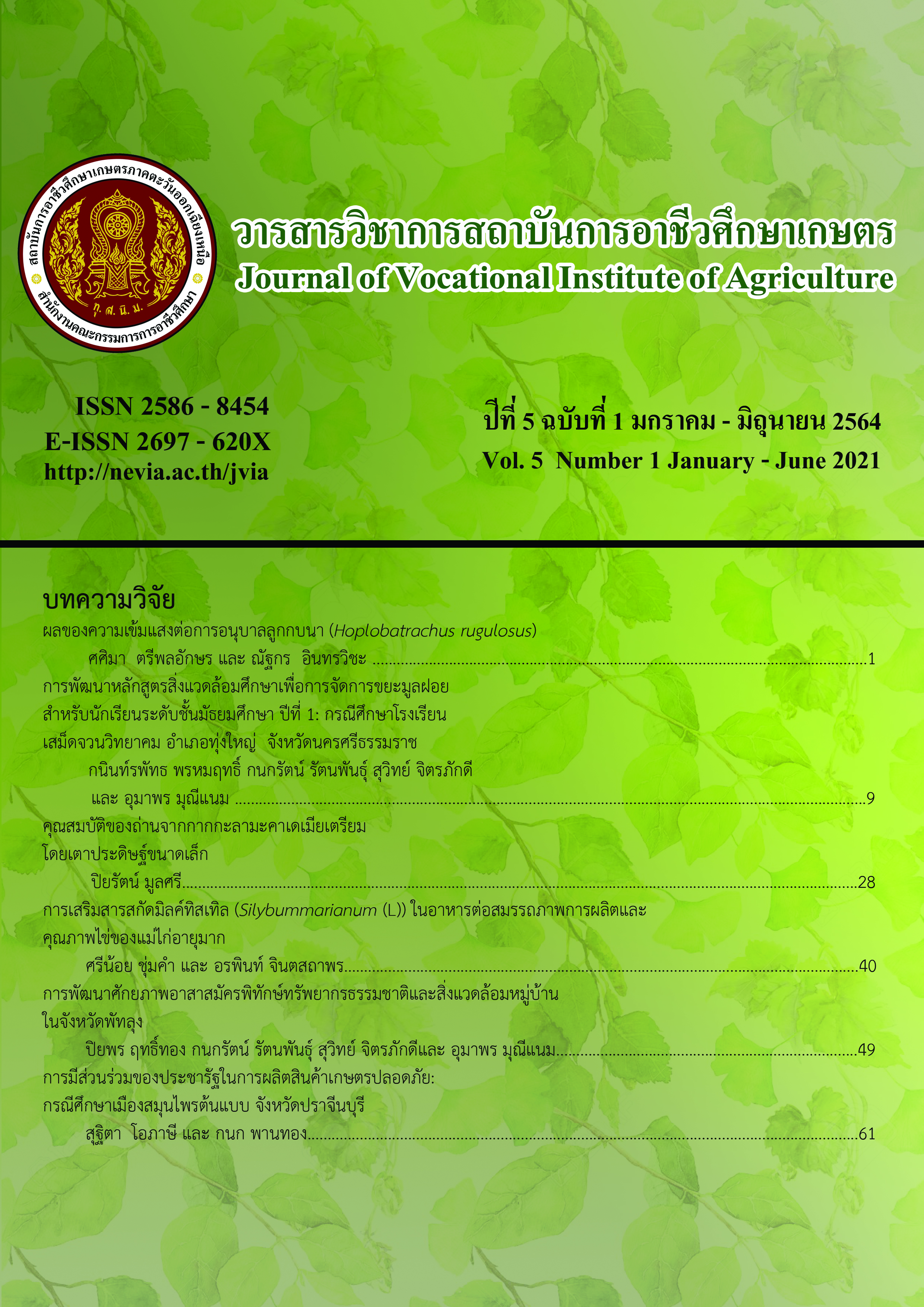คุณสมบัติของถ่านจากกากกะลามะคาเดเมียเตรียม โดยเตาประดิษฐ์ขนาดเล็ก
Main Article Content
บทคัดย่อ
งานวิจัยนี้มีวัตถุประสงค์เพื่อศึกษาคุณสมบัติของถ่านจากกากกะลามะคาเดเมียเตรียมโดยเตาประดิษฐ์ขนาดเล็กถ่านกะลามะคาเดเมียจากเศษกะลามะคาเดเมียเหลือทิ้งจากการเกษตรมีองค์ประกอบของเซลลูโลส เฮมิเซลลูโลส ลิกนินและเถ้าอยู่ในสัดส่วนร้อยละ 28.9 30.5 40.3 และ 0.3 โดยน้ำหนักตามลำดับ การเตรียมถ่านกะลามะคาเดเมียโดยกระบวนการคาร์บอนไนเซชันของเศษกะลามะคาเดเมีย 3 กิโลกรัม ด้วยเตาเผาประดิษฐ์ขนาด 54 ลิตร ใช้ระยะเวลาตลอดกระบวนการคาร์บอไนเซชันน้อยกว่า 3 ชั่วโมง มีอุณหภูมิสูงสุดของการเผาในช่วง 400-500 °C ได้ผลผลิตเป็นถ่านกะลามะคาเดเมียคุณภาพดี คิดเป็นร้อยละของผลผลิตเท่ากับ 40.7 ถ่านที่ได้มีลักษณะมันวาว มีความสามารถในการนำไฟฟ้าได้ มีค่าการดูดซับไอโอดีนเท่ากับ 374.7 mg g-1 ถ่านที่ได้มีค่าความหนาแน่นเท่ากับ 0.46 g cm-3 จากการวิเคราะห์สมบัติเชิงประมาณพบว่ามีปริมาณคาร์บอนคงตัว ปริมาณเถ้า ปริมาณความชื้น และปริมาณสารระเหยได้ อยู่ในสัดส่วนร้อยละ 83.2 6.3 4.3 และ 6.2 โดยน้ำหนัก ตามลำดับ นอกจากนี้ยังพบว่าค่าพลังงานความร้อนสูง (HHV) ของถ่านกะลามะคาเดเมียที่เตรียมได้ โดยการวิเคราะห์ด้วยเครื่องบอมคาร์ลอริมิเตอร์ มีค่าเท่ากับ 17.68 MJ kg-1 (หรือ 4,223 kcal kg-1)
Article Details

This work is licensed under a Creative Commons Attribution-NonCommercial-NoDerivatives 4.0 International License.
เนื้อหาและข้อมูลในบทความที่ลงตีพิมพ์ใน Journal of Vocational Education in Agriculture ถือเป็นข้อคิดเห็นและความรับผิดชอบของผู้เขียนบทความโดยตรง ซึ่งกองบรรณาธิการวารสารไม่จำเป็นต้องเห็นด้วยหรือร่วมรับผิดชอบใดๆ
บทความ ข้อมูล เนื้อหา ฯลฯ ที่ได้รับการตีพิมพ์ใน Journal of Vocational Education in Agriculture ถือเป็นลิขสิทธิ์ของJournal of Vocational Education in Agriculture หากบุคคลหรือหน่วยงานใดต้องการนำทั้งหมดหรือส่วนหนึ่งส่วนใดไปเผยแพร่ต่อหรือเพื่อกระทำการใดๆ จะต้องได้รับอนุญาตเป็นลายลักษณ์อักษรจาก Journal of Vocational Education in Agriculture ก่อนเท่านั้น
References
Mereles, L. G., et al. (2017). Chemical composition of Macadamia integrifolia (Maiden and Betche) nuts from Paraguay. International Food Research Journal, 24(6), 2599-2608.
Wechsler, A., et al. (2013). Macadamia (Macadamia integrifolia) shell and castor (Ricinos communis) oil based sustainable particleboard: A comparison of its properties with conventional wood based particleboard. Materials and Design, 50, 117-123.
Wang, C-H., et al. (1995). Deformation and fracture of Macadamia nuts Part1: Deformation analysis of nut-in-shell. International Journal of Fracture, 69, 14.
Nhuchhen, D. R. & Abdul Salam, P. (2012). Estimation of higher heating value of biomass from proximate analysis: A new approach. Fuel, 99, 55-63.
Schuler, P., et al. (2014). Structure-function relationships in Macadamia integrifolia seed coats-fundamentals of the Hierarchical microstructure. PLOS ONE, 9(8), 1-14.
Moonsri, P. & Hutem, A. (2018). Biomass-briquettes fuel from local wisdom for producer gas production. Kasem Bundit Engineering Journal, 8 (special issue), 286-295.
Teeta, S., et al. (2017). Thermal properties of green fuel briquettes from residue corncobs materials mixed macadamia shell charcoal powder. Journal of Physics: Conference Series, 901, 012042.
Fan, F., et al. (2018). Preparation and properties of hydrochars from macadamia nut shell via hydrothermal carbonization. Royal society open science, 5, 1-10.
Dejang, N., et al. (2015). A preparation of activated carbon from macadamia shell by microwave irradiation activation. Energy Procedia, 79, 727-732.
Ahmadpour, A. & Do, D. D. (1997). The preparation of activated carbon from macadamia nut shell by chemical activation. Carbon, 35(12), 1723-1732.
Technical Association of the Pulp and Paper Industry. (1999). Alpha, beta and gamma cellolose in pulp. Tappi Rule T203 om-88. Atlanta: TAPPI
Browing, B. L. (1963). Handbook of Wood Chemistry and Wood Composite. New York: Interscience Publishers.
Technical Association of the Pulp and Paper Industry. (2002). Test method T 222 om-02 acid-insoluble lignin in wood and pulp. Atlanta: TAPPI
Technical Association of the Pulp and Paper Industry. (2002). Test method T211 om-02 ash in wood, pulp, paper and paperboard. Atlanta: TAPPI
Moonsri, P., et al. (2016). Production of activated carbon from moldy damaged tamarind pod. Applied Mechanics and Materials, 885, 137-142.
Han, J. S. & Rowel, J. S. (1996). Chemical composition of fibers. Boca Raton (FL): CRC Press.
